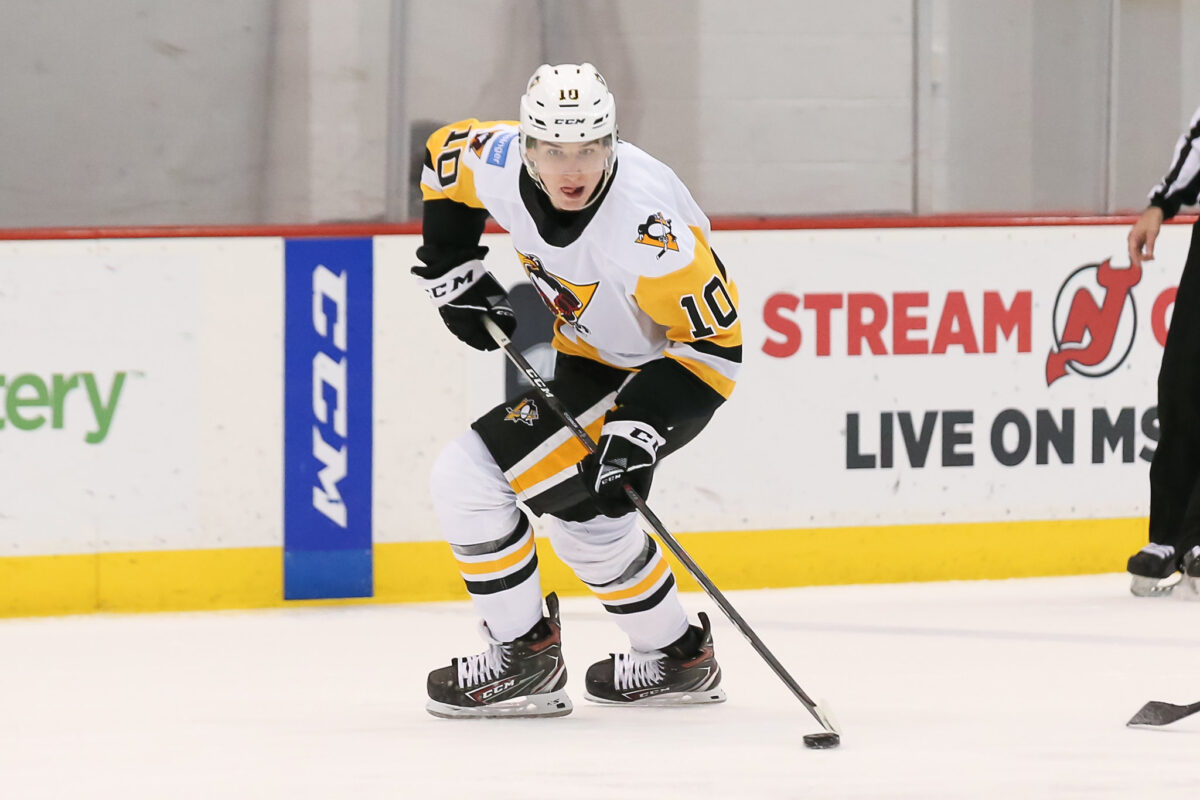The idea of a fully healthy Pittsburgh Penguins lineup seems like a fairytale, but one day it will happen. In the near future, Jeff Carter and Kris Letang will be out of COVID protocol. Sidney Crosby and Evgeni Malkin will eventually return. Bryan Rust has returned to skating on his own.
Related: Penguins’ Depth Steps Up in Early Season Success
Soon enough, the Penguins will be back at full strength, but there is a relatively new face that should still be in the lineup when that time comes. Rookie forward Drew O’Connor has impressed during his second stint in Pittsburgh, and earned the right to remain with the NHL club.
O’Connor Earned the Spot
It’s possible O’Connor may have been ready to play at the NHL level last season, but it just couldn’t happen given worldly circumstances. He did play in 10 games, and collected his first career point in his first game, but he outright did not look good enough for the NHL. Those 10 games, however, came after an unpredictable offseason, a shortened training camp, and no preseason.

O’Connor made his way to the taxi squad out of camp, and eventually made it into 10 NHL games. Aside from his first game, he looked mostly invisible in Pittsburgh. A below average Corsi percentage and no numbers to speak of, he was sent to the American Hockey League (AHL) Wilkes-Barre/Scranton Penguins. WBS is exactly where he should have started last year to progress his development.
In 20 games with the WBS Penguins, O’Connor scored seven goals and 12 assists for 19 points. Those are solid numbers for a 22-year-old in his first professional season. He was determined to improve himself over the offseason and earn a spot in the NHL. With a full camp and preseason, he was able to do that.
Thanks to a more intensive offseason, it was clear O’Connor had grown into a much better and more confident player. He cracked the opening night roster, and picked up an assist. He was scratched the second game, but was brought back to start an eight game home stand and he’s been one of the Penguins’ most important players.
In five games so far this season, O’Connor has three goals and two assists for a tie for the team-leading five points. Danton Heinen and Evan Rodrigues have the same stat line. O’Connor’s play has been noticed with a pair of multi-point games, including a two (could have been four) goals in a blow out victory over the Toronto Maple Leafs.
New Patric Hornqvist?
Ever since the Penguins traded away fan-favorite Patric Hornqvist, the team has been missing an important aspect to success: a power forward who isn’t afraid to go to the front of the net. So far, it looks like O’Connor is the perfect candidate to take that position.
When Hornqvist was with Pittsburgh, he was one of the most consistent goal scorers on the team, but it went mostly unnoticed. He put up around 20 goals every year because he parked himself in front of the net and didn’t give up space. It’s the perfect role for O’Connor to fill, and it looks like he’s already off to a good start in stepping in.
O’Connor stands at 6-foot-3, 200 pounds with plenty of body to screen goalies and be a pain in front of the crease. More than just his size, though, the big forward has scored a few goals, but none of them have been clean. All three have come from a giveaway, a deflection, or a pass off a defender’s foot. He’ll take the goals any way he can get them, but the building blocks are being set for a net front presence.
How Does O’Connor Fit?
This is the tricky part of keeping O’Connor in the lineup. Where does he fit and who gets taken out? Does the move involve a trade? Or an attempt to pass someone through waivers to the minors? Regardless, running a team in the NHL is a business, and O’Connor is what’s best for business at the moment.
It’s with that thought that should ease the sting of sending Dominik Simon back to the minors, or making Rodrigues a regular healthy scratch. One benefit O’Connor brings to the lineup is his ability to play either center or wing. When Jeff Carter was placed in COVID protocol, it was O’Connor who stepped into the second line center role and scored a pair of goals.
An even more intriguing idea, that is far-fetched but an idea, would be keeping O’Connor as a center and moving Malkin to a wing. Let’s not totally write this off just yet. It wouldn’t be the first time a Penguins’ Hall of Fame center moved to the wing to play on the same line with a No. 10.
For anyone that can recall the line of Ron Francis centering Mario Lemieux and Jaromir Jagr, they know it was something special. To be clear, Malkin and O’Connor are no Lemieux and Francis, but the move was made for the betterment of the team. Moving Malkin to the wing would push someone out of the lineup, but at this rate, O’Connor seems like the guy you can’t lose.
No matter how the lineup takes shape upon the return of injured players, O’Connor has done plenty to prove he’s worthy of staying in the NHL lineup. It will take more work from the rookie forward, and he will have to remain consistent, but he is already on the right path.